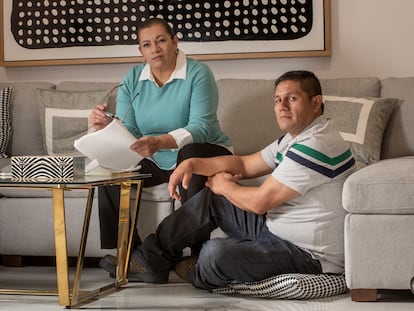Cries for help ignored: A wave of suicides at a Mexican women’s prison suggests pattern of negligence
The National Human Rights Commission has filed a detailed complaint with penal authorities and the Morelos State Prosecutor’s Office for violating the right to health, physical integrity, life and justice of 13 women found dead in a federal maximum security prison near Mexico City

On March 19, 2023, at 10:00 p.m., the women in Module C of Mexico’s Federal Prison No. 16 started shouting for help: “Seriously! She’s going to hang herself! Don’t do something stupid, don’t do it, help!” An inmate had tied some sheets to the bars of her cell and was attempting to take her own life. It took 20 minutes for prison guards to arrive. They had no tools to cut the cloth. They went to get another inmate who had a pair of contraband scissors. They managed to cut the woman down, but the doctor took another seven minutes to arrive. He only had a stethoscope and an oximeter. The woman died. She was the first of 11 inmates to lose their lives inside the Center for Social Rehabilitation (Cefereso) No. 16 this past year. Two others killed themselves in 2021 and 2022. The spate of suicides has prompted Mexico’s National Human Rights Commission to submit a harsh condemnation to prison officials and the Morelos Prosecutor’s Office, who they accuse of violating the rights to health, physical safety, life and justice of the 13 victims. The wave of suicides has put Mexico’s only federal women’s prison in the spotlight.
Cefereso 16 is a massive concrete structure located in Coatlán del Río, in the south-central Mexican state of Morelos, about 90 miles south of Mexico City. The population of this federal prison has gone from 783 inmates in October 2021 to 1,220 two years later. A staggering 41% of the facility’s prisoners have not been convicted or sentenced for any crime. That is, 512 of the women held in the maximum-security prison have not been found guilty by a judge (there are no jury trials in Mexico). “Two hundred and twenty-two women have been waiting more than nine years to receive a sentence,” says María Ana del Valle, the coordinator of community interaction for CEA-Justicia, a Mexican human rights organization. Many of the inmates are held in unofficial pre-trial detention, a controversial mechanism that forces the accused to remain incarcerated as they await trial. Mexico has been sanctioned by the Inter-American Court of Human Rights for this practice.
The conditions inside Cefereso 16 are no secret. Relatives of the incarcerated have repeatedly denounced the lack of water, both for drinking and for washing, as well as the poor state of the food, which in 2022 caused a massive outbreak of food poisoning, affecting some 400 women. Family members have also denounced the near total isolation suffered by their loved ones, as well as the lack of activities for inmates and the absence of medical attention. Angela Guerrero, director of CEA-Justice, describes the prison as “a cemetery of the living.” What families and human rights organizations have long known has now leapt into the public spotlight.
This week, the National Human Rights Commission (CNDH) issued a report totaling more than 200 pages, based on a detailed investigation into the deaths at Cefereso 16. The report claims that prisoners resorted to writing signs and holding them up to security cameras in an effort to get the guards to intervene to save their companions, but that no one ever came to help; that inmates do not receive prescribed medication for depression or schizophrenia; that women with only a few months left on their sentence are taking their own lives due to the impossibility of finding work and contributing money to their families upon release; and that women in the prison are being mistreated by security personnel and other inmates, without any authority intervening. The CNDH has confirmed that the psychological attention received by six of the 13 women whose cases are being investigated was insufficient. The other seven women did not even have access to that basic resource.
A chronology of deaths
The second woman to die in 2023 ended her life on July 24. She had been in prison for barely a year. Prior to her arrest, at her home in Ciudad Juárez, she had not suffered any known psychological issues. She was diagnosed with depression on July 16, and had harmed herself that same month following a breakup. The prison authorities only offered her one form of treatment: active listening. She died by asphyxiation. On August 2 at 11:00 a.m., a third inmate committed suicide, 18 months after her arrival from a prison in Ecatepec, in the state of Mexico. A family member reported to the CNDH that the woman had been assaulted by guards. By February, she had developed her first symptoms. A day before her death, she reported feeling bad, having a loss of appetite, inflicting self-harm and suffering sudden mood swings. She was diagnosed with a probable anxiety disorder that required urgent psychiatric evaluation. The psychiatrist did not arrive in time.
The fourth victim died on August 14. She worked in the industrial area of the prison and was in a relationship with another inmate, but they had been separated for three months. They tried to revive the relationship without success. She had been transferred from the Aquiles Serdán prison in the state of Chihuahua a little over a year ago. The next woman to die, on September 3, was originally from Mexico City and had served part of her sentence in the federal prison of Tepic, in Nayarit, beginning in 2015. She was quiet and stayed out of trouble, according to other inmates. Her family still doubts that it was a suicide, because the mechanism of injury that caused her death was never specified, and the images they were shown of the cell were inconsistent.
On September 21, after just one month at Cefereso 16, another woman died. The authorities told the CNDH that “she was not on the suicide risk list and was an extremely calm inmate, but on the day of the incident, she had received a call from her public defender, who told her that he ‘couldn’t do anything for her.’” However, medical documents dated September 2 state that she had suffered a brief loss of consciousness, and that she also suffered from an antisocial disorder for which she had not received any care.
The seventh woman to die had been in the federal prison since March 8. She died on October 24. On November 4 and 8, two other inmates died. Another died on November 29. The last death of the year was recorded on December 6. Hardly anything is known about these last five women. There is not even any evidence of suicide. The CNDH says it has requested documents relating to the cases from prison authorities, who have refused to provide any information.
“They were driving them to kill themselves”
The National Human Rights Commission’s diagnosis of the situation is devastating: security personnel are in short supply, addiction prevention programs are insufficient, they don’t have therapeutic resources, they don’t implement risk-screening protocols, and there are various irregularities “that can lead the commission of suicide to start a domino effect.” The research states: “A lack of attention to mental and physical health, prolonged confinement, restricting communication with the outside world, a lack of productive, creative and athletic activities, and the isolation and separation of inmates have deeply fractured their identities, creating an emotional climate of hopelessness, impotence, and a sense of insignificance as people.”
In short, the CNDH identifies omissions and inaction on the part of authorities, emphasizing the importance of placing responsibility on the people who were in charge of Cefereso 16 when the women died, because these individuals “failed to comply with their obligations to safeguard the psychophysical integrity and lives of inmates.” The report states that there were common factors “that drove the women to take their own lives,” and that the authorities did nothing. The Federal Public Defender’s Office has also filed a complaint regarding this alleged pattern of negligence.
The CNDH also sent their report and recommendations to the Morelos Prosecutor’s Office, given that the investigation found significant evidence that prosecutors had “failed to comply with fundamental issues regarding the human right of access to justice and truth,” citing the fact that, in most cases, they did not even investigate the potential involvement of other individuals in the deaths of inmates. “Given what little evidence is available, it is not possible to identify actions for avoiding acts of physical and psychological abuse,” the report reads.
In light of the situation, the commission is demanding that the 13 women be included in Mexico’s National Registry of Victims, along with 18 family members identified as indirect victims, so that they can receive free psychological care and compensation. In addition, the CNDH has requested the creation of a group of specialists to carry out an investigation into “all possible factors that are leading to suicide events in Cefereso 16.” The commission also recommends that the federal prison institute a mental health awareness day, with workshops on managing stress and emotions, and that authorities design a short, medium and long-term strategy to address the issue. This strategy, the commission states, should include the permanent, 24-hour presence of psychological staff inside the prison.
The report also instructs prison authorities to incorporate more “recreational, artistic and occupational activities at least every month,” and to seek out companies that can offer paid employment to female inmates. The CNDH also emphasizes the importance of loosening restrictions on communications with the outside world, given that inmates are currently only allowed one 10-minute phone call per week and one visit every 11 days. “The frequency of phone calls should be updated, as should the maximum duration allowed for calls,” says the commission, which is also taking into account the needs of women transferred from other prisons in other states by urging authorities to allow access to video calls, so that they can communicate with loved ones far away. The CNDH concludes its report by emphasizing that these women, who have been forgotten by the system, also deserve a dignified life.
Sign up for our weekly newsletter to get more English-language news coverage from EL PAÍS USA Edition
Tu suscripción se está usando en otro dispositivo
¿Quieres añadir otro usuario a tu suscripción?
Si continúas leyendo en este dispositivo, no se podrá leer en el otro.
FlechaTu suscripción se está usando en otro dispositivo y solo puedes acceder a EL PAÍS desde un dispositivo a la vez.
Si quieres compartir tu cuenta, cambia tu suscripción a la modalidad Premium, así podrás añadir otro usuario. Cada uno accederá con su propia cuenta de email, lo que os permitirá personalizar vuestra experiencia en EL PAÍS.
¿Tienes una suscripción de empresa? Accede aquí para contratar más cuentas.
En el caso de no saber quién está usando tu cuenta, te recomendamos cambiar tu contraseña aquí.
Si decides continuar compartiendo tu cuenta, este mensaje se mostrará en tu dispositivo y en el de la otra persona que está usando tu cuenta de forma indefinida, afectando a tu experiencia de lectura. Puedes consultar aquí los términos y condiciones de la suscripción digital.
More information
Archived In
Últimas noticias
A survivor’s account of the Interoceanic Train accident: ‘We were scared because of the speed on the curve’
The Interoceanic Train, the Mexican alternative to the Panama Canal
What is known about the Interoceanic Train derailment in Oaxaca
Trump turns a Minnesota fraud allegation into ammunition for his MAGA army against Democrats
Most viewed
- Oona Chaplin: ‘I told James Cameron that I was living in a treehouse and starting a permaculture project with a friend’
- Reinhard Genzel, Nobel laureate in physics: ‘One-minute videos will never give you the truth’
- Why the price of coffee has skyrocketed: from Brazilian plantations to specialty coffee houses
- Pablo Escobar’s hippos: A serious environmental problem, 40 years on
- Chevy Chase, the beloved comedian who was a monster off camera: ‘Not everyone hated him, just the people who’ve worked with him’











































